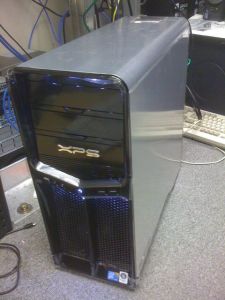Well, it looked spectacular.
I'm referring to NASA's recent launch of the Ares 1-X, billed as the prototype of the Ares 1 as a crew launch vehicle, a fancy term for a manned space booster. The rocket is said to have performed as planned, and ushered in the era of the Ares rockets to replace the Space Shuttle next year. Only it won't. In fact, the much-hyped Ares 1-X was much ado about nothing.
Yes, the rocket that thundered aloft from NASA's Launch Pad 39B sure looked like an Ares 1. But that's where the resemblance stops. Turns out the solid booster was - literally - bought from the Space Shuttle program, since a five-segment booster being designed for Ares wasn't ready. So they put a fake can on top of the four-segmented motor to look like the real thing. Since the real Ares' upper stage rocket engine, called the J-2X wasn't ready either, they mounted a fake upper stage. No Orion capsule was ready, so - you guessed it - they mounted a fake capsule with a real-looking but fake escape rocket that wouldn't have worked if the booster had failed. Since the guidance system for Ares wasn't ready either they went and bought a unit from the Atlas rocket program and used it instead. Oh yes, the parachutes to recover the booster were the real thing -- and one of the three failed, causing the booster to slam into the ocean too fast and banging the thing up. So, why you might ask, if the whole machine was a bit of slight-of-hand rocketry did NASA bother to spend almost half a billion dollars (that's billion with a "b") in developing and launching the Ares 1-X?
The answer: politics.
Technical problems, the kind that follow every new rocket's development, have haunted the Ares like leftovers from Halloween. The rocket as currently designed shakes so much during launch that shock absorbers are needed beneath its capsule payload. All of this takes time to fix -- and money, money that NASA really doesn't have. To stave off critics, three years ago the Project Constellation managers conceived of the 1-X flight to supposedly show some progress. They could instrument the rocket with hundreds of sensors gathering information never before obtained during a booster use in a Shuttle mission. It would give the launch team some practice in the assembly of an Ares. And NASA would find out if something as ungainly as the Ares 1 design - a thicker top than the bottom booster - could survive during ascent through the Earth's atmosphere. Of course, all of the changes to the Shuttle launch pad to accommodate the Ares wouldn't be ready in time, so they decided to just leave all of the Shuttle hardware, such as the rotating tower that envelops the Shuttles there. A success might just buy more time for Ares to fix its problems.
And that's just what happened.
Meanwhile, the huge Ares V super booster is just a series of drawings. Unlike the plan used to send Neil Armstrong, Mike Collins and me to the Moon in 1969, whereby we used just one rocket to lift all of the elements of our Apollo spaceships, the current return-to-the-Moon plan requires not one rocket but two-one launch of an Ares 1 carrying the astronauts in the Orion capsule, and an Ares V lifting a big upper stage, a sort of space tug, and the lunar landing craft called Altair. Together, the two ships dock in orbit and then the tug, called the Earth Departure Stage, fires up for the outbound trip to the Moon. Two rockets in development; two launching systems. And two price tags. Two ways for failure to occur. Or delays to develop.
Worse yet, neither rocket alone can accomplish a deep space mission. And deep space, such as Mars is, as our friends in the recent Augustine report stated, our destination in space. These rockets were originally supposed to all be derivatives of the Space Shuttle-using four segment boosters and Shuttle engines - but the designs were changed to save money and development time. Neither of which has proven to be the case today. Our Augustine panel colleagues stated flatly that some new heavy lift rocket would be needed no matter which direction President Barack Obama chose for the space program. But Ares 1 is too small, barely able to lift the crew space capsule. And Ares V is too weak to boost all of the elements together.
What do we need? One rocket for all our deep space missions. Save the taxpayer's money by canceling the Ares 1 and V. And go "back to the future" in designing the big beast. So how do we get to the space station without Ares 1? Let the commercial space firms develop their own crew launchers, and crew vehicles. Why should Uncle Sam be in the people hauling business?
Here's my plan -- and yes, I am a rocket scientist -- cancel Ares 1 now and the version of the Orion capsule that is supposed to fly astronauts back and forth to the International Space Station. Instead, unleash the commercial sector by paying them for transportation services to the station. Could be capsules. Could be winged ships like the Space Shuttle, capable of flying back to a runway with its crews and cargoes, not splashing in the ocean like a cannonball. With the money saved, start developing a true heavy lifter worthy of the Saturn V's successor. Could be a side-mount rocket like the Shuttles, with a tank-and-booster set flanked by a payload pod jammed full of cargo-or a space capsule with astronauts in tow. Or new upper stages capable of deep space missions. Let's open 'er up to a true competition, with designs from inside -- and outside -- NASA. If we bypass a foolish Moon race and let the development of the Moon be an international affair, we will have time to refine the super booster to make sure it is compatible with our deep space goals, like missions flying by comets or asteroids -- or to the moons of Mars. Such a rocket would be ready when the time comes to colonize Mars. No more false starts and dead end rockets.
Maybe use innovative elements like new upper stage engines, or entirely new propulsion systems. Or designs truly evolved from the Shuttle era. The idea is to get the best thinking from rocketeers before we start spending Uncle Sam's space bucks.
I confess I have a design in mind that I and my team have worked on for years. It's called Aquila, and it is a true offspring of the Space Shuttle. It makes maximum use of the existing Shuttle infrastructure -- unlike the real Ares -- and Shuttle boosters, engines and the side-mounted design where today the winged orbiter rides into space. If we need bigger rocket engines, Boeing's RS-68 behemoth is always available, flight proven and flight tested aboard the Delta IV commercial launchers. You see, heavy lifting doesn't need to be heavy spending, if we do the job right.
But let the designers take the field-and may the best booster win. To paraphrase David Letterman, we don't need any stupid rocket tricks. Just good sound engineering. For without good new rockets to carry our payloads and crews, nobody is ever going to follow in Neil, Mike and my footsteps into deep space. And that's where we are destined to go.












































